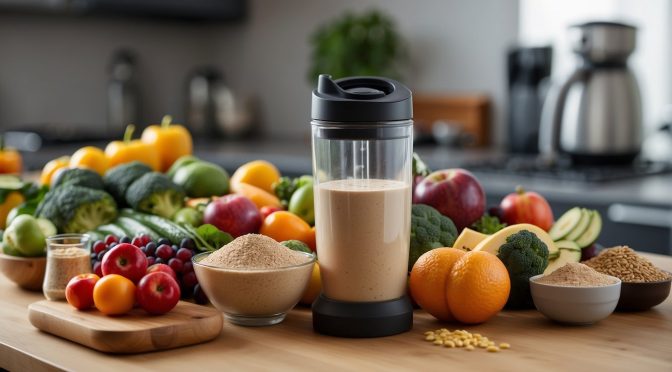When starting a journey to a healthy lifestyle, understanding the significance of each macronutrient can make a big difference in your gym diet plan. Protein is the building block of muscle. It’s a critical part of your diet when you’re working out regularly. Using a variety of protein sources ensures your muscles have what they need to repair and grow after an intense exercise session. Carbohydrates provide the energy needed to perform at your best. Fats are important for sustaining long-term energy and supporting cell growth.
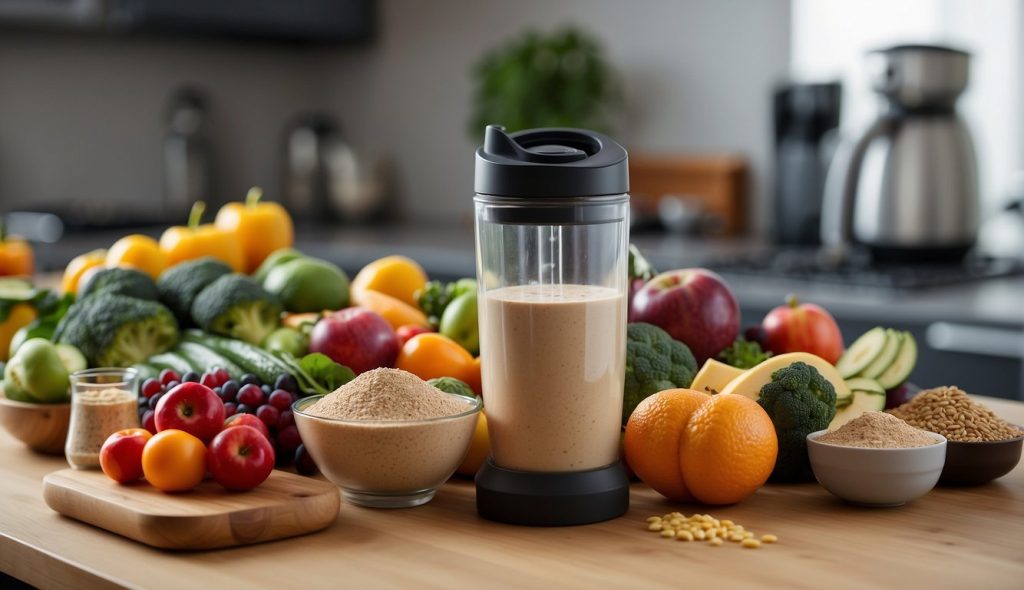
You do not have to complicate creating a diet plan that supports your gym activities. It involves selecting the right foods in the right proportions. This helps you meet your individual fitness goals. This could involve losing fat, gaining muscle, or improving athletic performance. By making informed choices about your nutrition, you can create a sustainable and effective path towards achieving a balanced and healthy lifestyle.
Key Takeaways
- Adequate nutrition is crucial for reaching fitness goals.
- Protein is vital for muscle repair and growth post-workout.
- Strategic meal planning ensures energy and performance optimization.
Importance of a Proper Diet in Achieving Fitness Goals
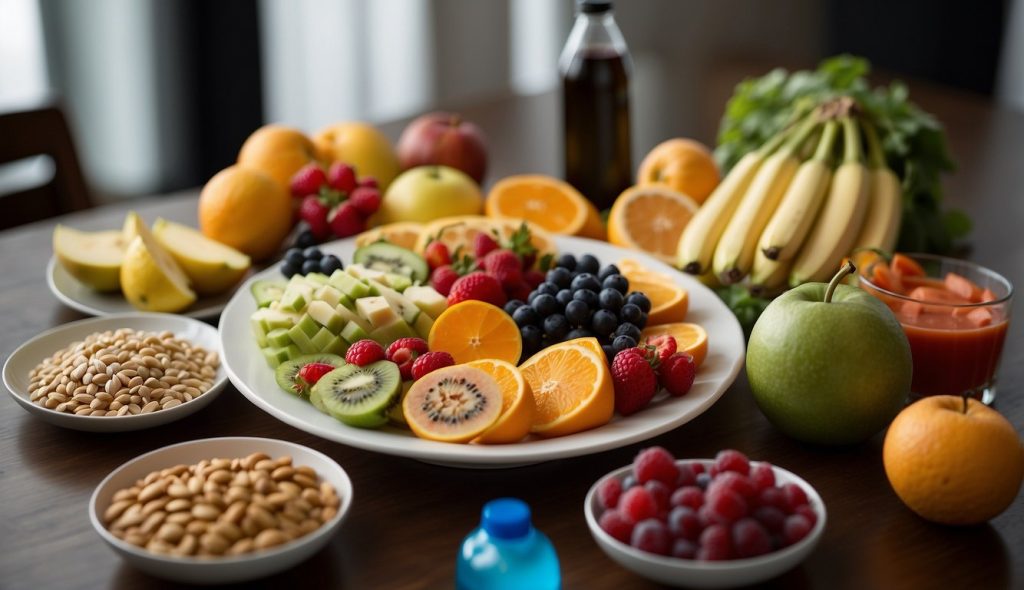
A well-structured diet is crucial for achieving fitness goals. Your body needs balanced macronutrients – carbohydrates, proteins, and fats – to function optimally. This is especially important when you’re actively working out.
We should not shun fats; they are vital for energy and hormone production. Aim to consume healthy fats from sources like avocados, nuts, and fish. On the other hand, carbohydrates are your body’s primary energy source. Choose whole grains, which are complex carbohydrates. They provide sustained energy without drastic blood sugar spikes.
Proteins are paramount for muscle growth and repair:
- You should aim to consume around 1.2 to 2.2 grams of protein per kilogram of your body weight daily. Emphasize lean sources.
- Sources: Common protein-rich foods include meat, fish, and dairy products.
- Amino acids are essential for muscle protein synthesis. They are the building blocks of muscle tissue.
Your calorie intake should align with your fitness targets:
- To gain muscle, consume more than your daily energy requirement.
- For fat loss, consume fewer calories than your body expends.
Here’s a sample table for daily protein targets according to body weight:
| Body Weight (kg) | Protein Intake (g) |
|---|---|
| 50 | 60 – 110 |
| 70 | 84 – 154 |
| 90 | 108 – 198 |
Simply consuming these nutrients isn’t enough. They need to be well-balanced in your diet. This will effectively support your fitness journey. Adequate hydration and micronutrient intake are also essential. They complement the macronutrients and meet your body’s needs.
Understanding Macronutrients
To optimize your gym diet, you need to understand macronutrients and their roles. It’s fundamental. Macronutrients are the building blocks that provide the energy necessary for your fitness routine and recovery.
Calculating the Ideal Grams of Protein Intake for Your Gym Diet
You can determine the amount of protein you need using your body weight. Sedentary individuals should aim for 0.8 grams of protein per kilogram of body weight. But if you’re actively working out, aim for 1.2 to 2.2 grams of protein per kilogram. For example, if you weigh 70 kg (154 lbs), your protein intake should range between 84 to 154 grams per day. Use this formula to calculate your needs:
Protein (grams) = Body Weight (kg) × [1.2 to 2.2]
Role of Protein in Muscle Growth and Repair
Protein plays a crucial role in building muscle mass and facilitating repair. During regular exercise, muscle fibers experience microtears. Amino acids are the building blocks of protein. They are essential for repairing these tears and building stronger muscles. Adequate protein can speed up muscle repair. It also helps muscles grow.
The Benefits of Incorporating Lean Protein Sources in Your Gym Diet
Including lean protein sources in your gym diet offers numerous benefits:
- Reduced fat content: Lean proteins provide essential nutrients without excessive fats. Examples include chicken breast, turkey, lentils, and non-fat Greek yogurt.
- Satiety: Protein-rich foods keep you full longer, helping with weight management.
- Metabolic boost: Your body burns more calories digesting protein compared to carbohydrates and fats.
Protein Sources for Gym Diets
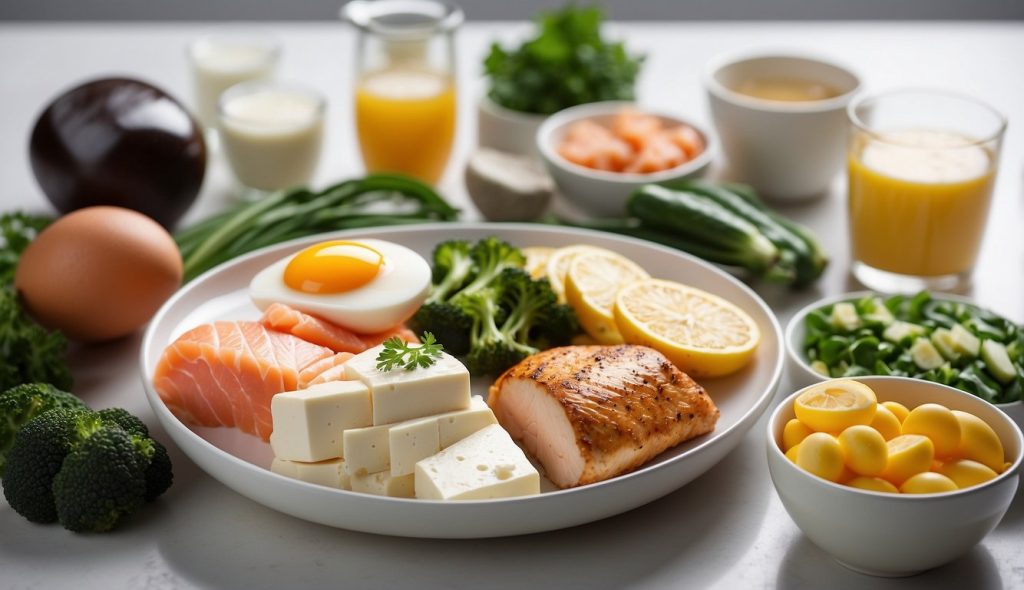
Incorporating high-quality protein into your gym diet is essential for muscle development. It also fuels your workouts. Below, you’ll find specific information on beneficial protein sources. These can support your fitness goals.
Incorporating Chicken Breast as a Primary Source of Lean Protein
Chicken breast is a staple in many gym diets because it has high protein and low fat. It’s an ideal source of lean protein. A typical 3-ounce serving contains about 26 grams of protein. This is crucial for building muscle. For the best results, eat grilled or baked chicken breast instead of fried. This minimizes unnecessary fats.
Exploring the Nutritional Value and Versatility of Sweet Potatoes
Sweet potatoes are nutrient-rich foods that provide complex carbohydrates, important for sustained energy during workouts. They are not a source of protein. You can combine sweet potatoes with a protein source, such as grilled chicken, to maintain a balanced diet conducive to muscle development.
The Significance of Including Egg Whites in Your Gym Diet
Egg whites are a pure form of lean protein. This is particularly beneficial for muscle repair and growth. Each egg white offers approximately 3.6 grams of protein with minimal calories. You can easily add them to your meals, such as omelets or protein-rich snacks. This ensures sufficient protein intake throughout your day.
| Nutrient | Amount per egg white |
|---|---|
| Protein | 3.6 g |
| Total Calories | 17 |
| Carbohydrates | 0.2 g |
| Fat | 0.1 g |
How Almond Butter Can Be an Excellent Source of Energy for Workouts
Almond butter is a nutritious option. It provides healthy fats and can help sustain energy levels during intense workouts. It also has protein and you can spread it on whole-grain toast or add it to smoothies. A single tablespoon offers around 3.5 grams of protein. It also contains a significant dose of vitamin E and magnesium.
Maximizing Protein Intake with Protein Shakes and Powders
Protein shakes and powders, such as whey protein, are a convenient and efficient way to boost your protein intake. This is especially true after a workout. These protein supplements are quickly absorbed by the body. They assist in prompt muscle recovery and growth. The amount of protein in one serving of whew protein powder depends on the product. It can provide around 20-30 grams of high-quality protein.
Be vigilant about reading labels. Choose a protein powder with a minimal amount of additives and fillers. Always choose a product that aligns with your dietary requirements. Also, choose a product that aligns with your fitness objectives. Remember to incorporate these shakes as part of a balanced diet for optimal results.
Balanced Meal Planning for Gym Diets
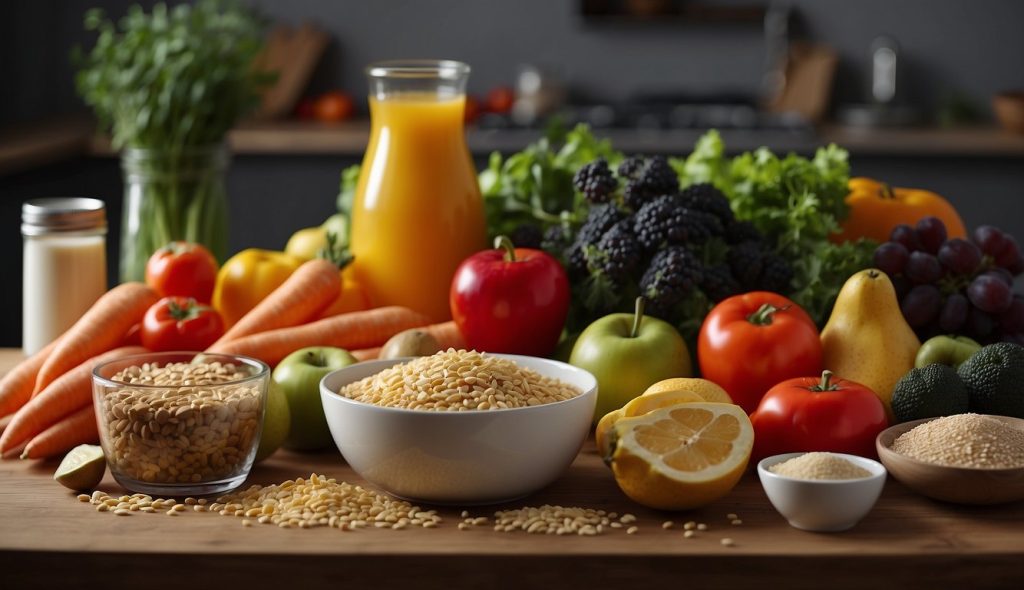
A well-crafted meal plan is essential for supporting your gym efforts. It ensures you get a balanced diet rich in nutrition to optimize performance. Including a variety of foods is key to keeping your meals interesting and nutritionally complete.
Designing a Meal Plan That Includes a Variety of Fresh Fruits and Vegetables
In your meal plan, prioritize a rainbow of fruits and vegetables. This guarantees a diverse intake of antioxidants, vitamins, and minerals. For example:
- Fruits: Apples, bananas, berries, citrus fruits, and melons.
- Vegetables: Spinach, kale, broccoli, carrots, and bell peppers.
These should account for a substantial portion of your meals. They give you a wide range of nutrients and keep calorie counts in check.
Peanut butter is important for providing sustained energy during workouts. It contains healthy fats.
To maintain energy levels during workouts, integrate healthy fats into your diet. Foods high in unsaturated fats, such as nut butter, are ideal. Consider the following:
- Peanut Butter: A great source of energy, and when unsweetened, it’s healthful.
- Other Nut Butters: Almond, cashew, or sunflower seed butter are excellent alternatives.
These fats provide sustainable energy. They also support cell growth and hormone production.
Incorporating Steamed Vegetables to Ensure High Nutrient Content in Your Meals
Steamed vegetables retain more nutrients compared to other cooking methods. Here’s how to incorporate them:
- Serve a side of steamed broccoli, carrots, or green beans with your main sources of protein.
- Add steamed vegetables to salads, omelets, or whole grain dishes to enhance their nutrition profile.
Steaming preserves the integrity of the vegetables’ vitamins and minerals. It ensures you get the maximum nutrient content from your meals.
Gym Diet: Frequently Asked Questions
Q: Which type of diet is best for gym?
A: The best gym diet has a balance of macronutrients (carbohydrates, protein, and fats). It supports your energy needs, muscle recovery, and overall health. People who go to the gym are generally advised to eat a healthy diet. It should include a variety of whole foods. Such as lean proteins, whole grains, fruits, vegetables, and healthy fats. It’s also important to stay hydrated by drinking plenty of water. Individual dietary needs may vary based on specific fitness goals and body composition. In addition, they may also vary. They may also depend on any underlying health conditions. So, it’s always a good idea to consult with a nutritionist or dietitian to create a personalized plan.
Q: What should I eat at the gym?
A: You may not eat during your actual workout at the gym. But, it’s important to fuel your body properly before and after your session. Before your workout, consider having a small meal or snack. It should include a balance of carbohydrates and protein. This will provide energy and support muscle function. This could be something like a banana with a spoonful of almond butter. Or a yogurt parfait with granola and fruit. Or a turkey and cheese sandwich on whole grain bread.
After your workout, focus on consuming a combination of protein and carbohydrates. This will help with muscle recovery and replenish energy stores. Good post-workout options include a protein shake with a piece of fruit. Also, a chicken and vegetable stir-fry with brown rice works. A smoothie made with Greek yogurt, spinach, and berries is another option.
It’s important to listen to your body. Adjust your pre- and post-workout nutrition based on your individual needs and preferences. As always, staying hydrated with water is crucial for optimal performance and recovery. This is true before, during, and after your workout.
Q: How do I make a diet plan for the gym?
A: Creating a proper diet plan for the gym involves considering your individual nutritional needs, fitness goals, and lifestyle. Here are some general steps to help you get started:
1. Assess your current eating habits. Take a look at what you’re currently eating. Identify areas for improvement. Consider the balance of macronutrients in your meals and snacks. Consider your overall calorie intake, too.
2. Set specific goals. Determine what you want to achieve with your gym diet. This could be building muscle, losing fat, improving performance, or simply maintaining overall health.
3. Calculate your calorie needs. You can estimate your daily calorie needs by using an online calculator. Alternatively, you can consult with a nutritionist for help. Consider your age, gender, weight, activity level, and fitness goals.
4. Plan your macronutrient intake. Once you have an idea of your calorie needs, consider how to divide your macronutrients. This will support your goals. For example, a typical gym diet may include a balance of protein, carbohydrates, and healthy fats. It emphasizes whole, nutrient-dense foods.
5. Create a meal plan based on your calorie and macronutrient needs. Plan your meals and snacks for the week. Include a variety of foods to ensure you’re getting a wide range of nutrients.
6. Monitor and adjust: Keep track of your progress and how you feel with your new diet plan. Make adjustments as needed to better align with your goals. Ensure you’re feeling your best.
Creating a diet plan for the gym can be complex. It’s always a good idea to seek guidance from a registered dietitian or nutritionist. They can help tailor a plan to your individual needs and provide ongoing support.
Q: Is gym 70% diet?
A: Both exercise performance and diet are important for overall health and fitness. However, the idea that “fitness is 70% diet” emphasizes nutrition’s significant impact on fitness goals. This simplifies the point. The specific percentage can vary from person to person based on individual circumstances and goals.
A balanced diet is crucial for achieving and maintaining fitness. It supports your energy needs, muscle recovery, and overall health. However, regular physical activity is also essential for building strength. It also builds endurance and cardiovascular health. This includes gym workouts.
Ultimately, diet and exercise work together to support overall health and fitness. It’s important to prioritize both aspects. Find a balance that works for your individual needs and goals.
Q: What happens if you lift weights but don’t eat enough protein?
A: If you lift weights but don’t eat enough protein, it can potentially impact your muscle recovery and growth. Protein is essential for repairing and building muscle tissue. Inadequate protein intake may lead to slower muscle recovery, reduced muscle growth, and increased risk of muscle loss.
When you engage in weightlifting, your muscles undergo stress and damage. Sufficient protein intake is necessary to support the repair and growth of muscle fibers. Your body may struggle to repair and build new muscle tissue without enough protein. This can hinder your progress in strength training and muscle development.
Make sure your diet includes plenty of protein. This is particularly true if you regularly lift weights or do other resistance training. The exact amount of protein needed can vary based on individual factors. These factors include body weight, activity level, and fitness goals. Consult with a nutritionist or dietitian. They can help you determine the right amount of protein for you.

